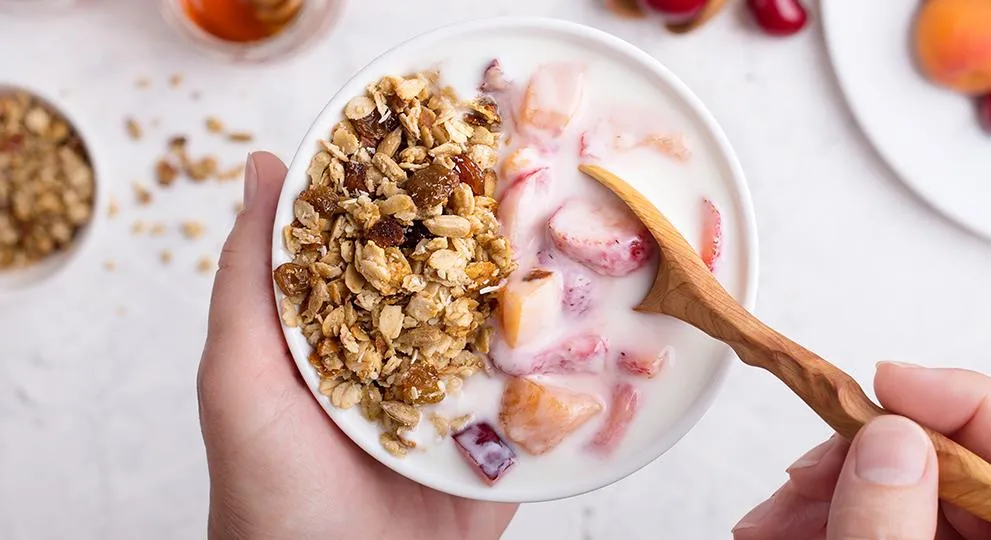How to manage your weight when you have cancer
How to manage your weight when you have cancer

Maintaining a healthy body weight is important during cancer treatment. Some people may need to prevent or manage weight loss, which can cause loss of muscle mass and strength. Other people may need to prevent or manage weight gain, which can contribute to the development of other serious medical conditions.
Keeping track of your body weight
Medicines used to treat cancer or other conditions can cause changes in appetite. This may impact the ability to eat normally, which can result in either weight loss or weight gain. Speaking with your healthcare team about your appetite and weight is an essential part of your care.
Work with your healthcare team to address weight loss or gain
It’s important to monitor your body weight changes during cancer treatment to avoid unintended weight loss or weight gain. Your healthcare providers may ask you to tell them how you’ve been eating and drinking and what your most recent weight is. You may be asked to get on a scale during your office visits.
Even if visits to your healthcare team are less frequent, your role in monitoring and managing your body weight is important. Speak with your healthcare team or registered dietitian for guidance on how best to monitor and manage your body weight and when to report any changes. In general, consider the following if more specific direction wasn’t given by your healthcare team:
- Weight gain: If you gain 5 pounds or more in 1 week, be sure to alert your medical team.
- Weight loss: If you lose 3 pounds or more in 1 week, be sure to alert your medical team.
Managing weight loss
You may experience changes in your appetite during cancer treatment. This can be from the symptoms of cancer or from side effects related to treatment. A decreased appetite can cause you to eat too little. Here are some ways to increase your food intake to help prevent unwanted weight loss:
- Time your meals. Set an eating schedule. Try eating meals at the same times every day and use the clock or an alarm as a reminder to eat. You may also find it helpful to eat smaller portions (½ meals) more frequently
- Choose foods rich in calories and protein. If you are eating less than usual, include high calorie and high protein foods. Foods like avocado, olive oil, butter and peanut butter can add calories to food. Adding ground nuts, eggs, beans or cheese to meals can add protein. As an example, instead of eating a piece of fruit by itself, pair a piece of fruit with a full-fat Greek yogurt or nut butter for extra calories and protein
- Choose healthy snacks. Snacking in between meals can help you to eat more throughout the day. Good choices include whole grain crackers with nut butter or cheese, a hardboiled egg, trail mix and yogurt and fruit
- Try liquid meals when you don’t want solid food. You can make your own healthy shakes, using ingredients like milk, yogurt, nut butter and fruit. Alternate between small meals and these types of liquids. Consider using ready-to-drink nutritional beverages to supplement in between meals if you aren’t able to make your own. Talk with your healthcare team about whether a supplemental nutritional beverage would be appropriate for you
Managing weight gain
Weight gain can result from a variety of factors that may include cancer treatment, appetite changes, use of steroids, fluid retention and inactivity. If you are experiencing weight gain, your healthcare team may advise you to keep track of and manage your weight. One way to do that is by eating the right portions in order to control your calorie intake. A serving size is a guideline for the right portion of food to eat.
- Control your portions. Each food group has a recommended serving size. You can find food serving size information on “Nutrition Facts” panels. In the chart below, you’ll find suggested serving sizes for each food group. While you can use measuring cups to become familiar with these portion sizes at home, eating out may be more challenging. The chart below may help you figure out the right portion size when you aren’t able to measure it yourself
|
FOOD GROUP* |
RECOMMENDED SINGLE SERVING† |
SAMPLE VISUAL PORTION |
|
FRUIT |
|
|
|
VEGETABLES |
|
|
|
GRAINS |
|
|
|
DAIRY |
|
|
|
NUTS |
|
|
|
BEANS/PEAS |
|
|
|
PROTEIN |
|
|
|
FAT/OIL |
|
|
*Choose lower sodium foods if your healthcare team has advised that your weight gain is related to fluid retention or edema.
† The recommended number of daily servings depends on your daily calorie needs. Speak with your doctor or registered dietitian to learn how many calories you need each day.
- Make healthy food choices. Avoid high-calorie foods like fried foods, fast foods, pizza, sausages, hot dogs, dishes baked with heavy cheese and oils, baked goods, ice cream, high sodium foods and sugar-sweetened beverages. Choose healthier options like baked or broiled lean poultry and fish, whole grains, beans and fresh fruit and vegetables. For example, just removing extra cheese from a sandwich can save you 75-100 calories for that meal
- Be mindful when eating out. It’s easy to overeat when you’re served a big portion at a restaurant. Consider splitting an entrée or taking half of it to go. You could also order one or two appetizer portions instead. If a restaurant allows special requests, you can ask for the sauces or dressings on the side. That way, you can control the amount you use
- Snack healthfully. A snack in between meals can help you manage hunger and reduce overeating during meals
Staying on track with your weight
Whether you are struggling with weight loss or weight gain, it can feel like a daily chore to manage. Keep a food journal to help you be more mindful when eating and stay within your daily calorie goal. It is also helpful to set realistic goals to keep yourself on track. Share your journal and communicate your goals with your healthcare team to get the guidance and support you need to achieve a healthy weight.
|
MY WEIGHT MANAGEMENT CHECKLIST |
|
¨ Understand your weight. Address any weight changes with your medical team. |
|
¨ To help manage weight loss, eat on a schedule and choose nutrient-dense foods. |
|
¨ To help manage weight gain, choose the right portions and avoid unnecessary calories from processed, high-sodium foods and sugar-sweetened beverages. |
|
¨ Keep a food journal to help you manage your eating habits. |
|
¨ Set goals to help you stay on track and manage your weight. |
This article has general information and is not meant to replace nutritional or health guidance that is specific to any individual. Speak to your healthcare provider before making any changes to your diet or lifestyle. Consult with a registered dietitian if you are on a restricted or modified diet.













